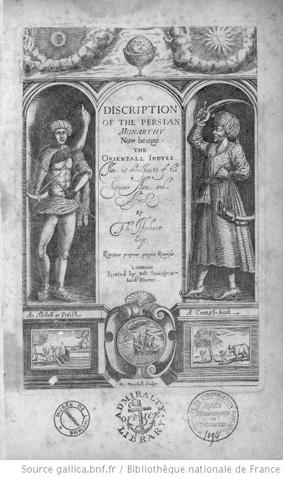Herbert visited Isfahan for “above twentie days, and no time idle” in 1627[1]. In each of his published editions the maydan was a high point: in 1634, the “chiefe ornament of the Citie… and to say truth, all the bravery, concourse, wealth and Trade is comprised in her”[2]; and from 1638, “without doubt as spacious, as pleasant and aromatick [sic] a Market as any in the Universe”[3].
The 1638 edition prettily introduces the architectural detail of Isfahan with: “Let me lead you into the maydan …”[4].
In 1634 Herbert wrote about the maydan:
“… tis built Quadrangular, though of unequal Angles. From North to South, is seven hundred seventy five of my paces, from East to West two hundred, but accounting the Ile [aisle] to the North issuing[5], is at least a thousand.
It is built in the form of our royal Exchange, with four Iles, and & court within, called the Hippodrome, so called from their running with horses there. Tis stored with all Merchandizes, chiefly Drugs, and to this place daily resort most Nations, as English, Dutch, Portugals, Arabians, Turkes, Jewes, Armenians, Muscovians and Indians” [6].
Herbert’s first edition does note the monuments around the maydan – but seems to see these as quite separate components. After his initial description of the maydan, there are some geographical notes, and general descriptions of “Hummums” (the Persians are “much given to bath”) and “Moscheas or Churches”. There is a description of Muslim worship. Only then does Herbert give a few details of the buildings about the maydan: “the King’s prime house”, and the Mint, and the Qaysariyya (which he describes as “like Chappels hung with Lampes … [of a] dainty splendour … hither sometimes the King repaires, and sees the Sodomitical Boyes and Wenches dance”[7]).
Later editions amend this, presenting the maydan and the monuments therein as an ensemble – and also remembering to include the mosque at the southern end of the maydan (the Masjid Shah)[8].
[1] Thomas Herbert, A relation of some yeares travaile, begvnne anno 1626. Into Afrique and the greater Asia, especially the territories of the Persian Monarchie, (London, 1634 – hereafter referred to as ‘TH 1634’),83.
[2] TH 1634, 84-86.
[3] Thomas Herbert. Some years travels into divers parts of Asia and Afrique. Describing especially the two famous empires, the Persian and the great Mogull… (London: 1638 – hereafter referred to as ‘TH 1638’), 156.
[4] TH 1638, 155.
[5] This surely refers to the qaysariyya.
[6] TH 1634, 86.
[7] TH 1634, 86-87
[8] TH 1638, 156. He also omits the analogy with “Chappels”, presumably deciding that this didn’t fit well with the “damned sin” with the “Catamites”.
